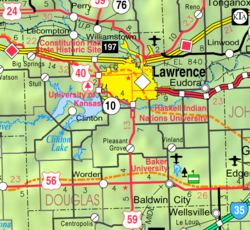History
The first settlement at Big Springs was made in the fall of 1854. [2] The town was founded by William Harper and John Chamberlain but had always been a popular watering hole along the Oregon Trail. It was named from the mineral springs nearby. [3] [4] On September 5, 1855, Big Springs was home to a free-state convention in which determined men vowed to give their lives to defend their homes from border ruffians from Missouri. The first sermon was preached in 1855 by Reverend W.A. Cardwell in the log home of Ephraim Banning. The first church was built a year later. [5] Also in 1856, the first post office was established, as well as the first schooling took place then in the town hall. The post office was discontinued in 1903. [6] The population did not grow, but hovered around 40 people, as there was no railroad running through the town.
According to the Lawrence Journal-World , Big Springs was the location of T. J. Custard's birth, making him the first American citizen to be born in Douglas County. [7]
Today it has a water tower, tool shop, church and a fire station that is part of the Lecompton Township Fire Dist. 1. Its mailing address is Lecompton.
In 2010, a building on the east side of town caught fire, leaving a restricted area of charred rubble.
This page is based on this
Wikipedia article Text is available under the
CC BY-SA 4.0 license; additional terms may apply.
Images, videos and audio are available under their respective licenses.




